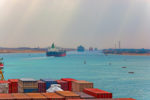
Think Tank
Consumers Want Greener Delivery Options — But Retailers Have to Explain Them

A package sits on a doorstep. Photo: Shutterstock.
Despite a growing public awareness of the many supply chain crises spurred by COVID-19, there remains a limited understanding of how delivery networks really run — and how to navigate eco-conscious options. Many retailers that offer green shipping and fulfillment choices are failing to educate their customers, and consequently wasting their own efforts.
That’s one of the conclusions of a recent study conducted by retail returns company goTRG, which found that consumers simply don’t understand or consider the impact of their online shopping habits on climate change and the environment.
Nearly 65% of those surveyed claimed they do not feel green guilt over the number of online orders they are having delivered, and 70% of consumers believe that products they return end up back on retailers’ shelves (or online marketplaces) — which, in fact, is rarely the case.
And yet, the survey found, a majority of consumers would be willing to accept slower deliveries if doing so were beneficial to the environment, and a substantial proportion would even pay more for “green” delivery options.
But critically, they just don’t trust retailers who try to flash green credentials. Asked, “Are you skeptical of sustainability pledges and promises from brands and retailers?” a stunning 70% of 1,100 respondents said “yes.”
Steve Rop, Chief Operating Officer at goTRG, says part of the problem is that measuring the mitigation of commerce’s impact on the environment is complicated, and that companies are not doing a good job of communicating clearly when they are actually doing the right thing. “Greenhouse gasses and carbon footprints and offsetting… it’s all so complicated!” he says. “How much really is that 500 tons of carbon that you prevented? And yet there’s really cool stories out there that are relatable but are not being marketed.”
How do we fix the disconnect that consumers really want greener options, but aren’t able to understand or trust when retailers are offering them? Rop has a few ideas to offer. “I think you need to provide non-pushy options,” he says. For example, packaging is a good place to start, he argues, partly because it’s physically real and right in front of you. Consumers have a hard time figuring out what’s more impactful to the environment when it comes to transportation — getting something delivered to their home vs. driving to the store, for example — and end up concluding it’s a wash, or that they can’t figure it out because it’s too complicated. But, in the case of packaging, it’s clear that you need more when an item is individually packaged for delivery compared to how it ends up on a shelf. And, quite often, Rop points out, home-delivered products come with return packaging included, which ends up getting wasted if the item isn’t returned. That could not only be avoided, but touted.
“Retailers need to start by separating out the pieces that for consumers are the most important,” Rop says. “Telling them that a return goes from your house to a UPS hub, then on to a DC… and you’ve lost them. There’s only so much space on a label to explain it. We need to get retailers to focus on educating consumers on what’s most important to them.” Designing delivery packaging that is recyclable, or made from recycled packaging, or that can easily be repurposed for returns is a great choice. And that’s not least because it shows credible evidence that the retailer means business when it comes to reducing its environmental impact.
Other ideas abound. “They can’t be pushy, and they can’t be complicated,” Rop says. These included retailers offering discounts on consolidated orders, or offering promotions or discounts to someone returning an item to a store so they buy something while they’re there, and mitigate the fact that it’s otherwise a heavy-burden transaction.
Another area is reducing what’s known as “bracketing” — the habit of online shoppers to buy an item in multiple sizes to be sure they get the right fit. Rop points to Nordstrom, which has gone after this problem in a smart way by recording how brands differ and alerting shoppers that, the last time they bought something from another brand, it was a size 12, so this brand will probably run closer to a 14, for example.
Delivery should still be on the radar for sure, Rop says. It makes obvious sense to push back against the current common phenomenon of multiple daily delivery rounds by multiple service providers to the same locations. Why not put all the UPS deliveries to a neighborhood on one truck per day? Even better, why not consolidate all deliveries to that neighborhood by any carrier in a consolidation center on the outskirts of town for a single daily delivery run? This approach has worked spectacularly well in the Regent Street area of Central London, where delivery vehicles were previously accounting for 35% of traffic so dense it was interfering with the street’s attraction as a shopping area. Deliveries to each store are now consolidated at a hub outside the center, made into a single consignment and delivered at a pre-arranged time via an electric truck. As well as providing a more cost-effective way to manage stock, the program has produced an 80% reduction in truck movements associated with retailers on Regent Street, while helping drive footfall, increase sales, and address environmental targets.
There was a unique focus of will in this case — the entire two-kilometer stretch of shop fronts and offices is owned by The Crown Estate, so they were able to implement the program comprehensively. But Rop sees potential for such strategies, particularly when every consumer in a city or town can easily take note of the number of branded delivery trucks dashing around.
“It would be nice to get an Amazon delivery just once a day, I think most people in most neighborhoods would like that. Especially if they say it’s at noon and that’s reliable,” he says. “And it would optimize costs for deliveries — I like that.”
There’s been a significant cultural shift in the U.S. in the last few years towards faster and faster delivery, with the assumption that that’s what consumers crave. But goTRG’s survey seems to imply otherwise. Asked, “Would you be inclined to wait longer for products if it means they could be shipped in a more eco-friendly fashion (for online purchases)?” more than 76% said yes, and close to 23% said they’d even be willing to pay more for this option.
“Do you really need a one-hour delivery from Prime? Do you really want four or five boxes to throw out, instead of one?” asks Rop. He doesn’t think people want packages left all day at their door, either, especially in dense urban areas where package theft is a problem. It can actually end up being a matter of convenience to the buyer. Most people would prefer predictability to speed, he says. “Predictability would be great.”
And deeper into the supply chain, myriad opportunities await. Rop gives another example of the work goTRG has done with a major retailer, where the vice president of reverse logistics recognized an opportunity in returned toys. Because returned baby products, especially toys, have issues with sanitation as well as other logistics challenges, the retailer decided to recycle them back into raw materials and offer those to their private label manufacturers to create hangers and clothing baskets.
“That’s cool!” Rop says. But communicating that, simply and clearly, to consumers is the key to change, because consumer demand has the power to shift markets faster and more dramatically than a conference hall full of well-meaning CEOs. And it’s not happening fast enough, Rop says. “If you look at that product, it doesn’t tell that story. So, they did this and sure, they got some lower costs, but to me, this is about how we prevent stuff going to landfill. That’s what the consumer wants.”






